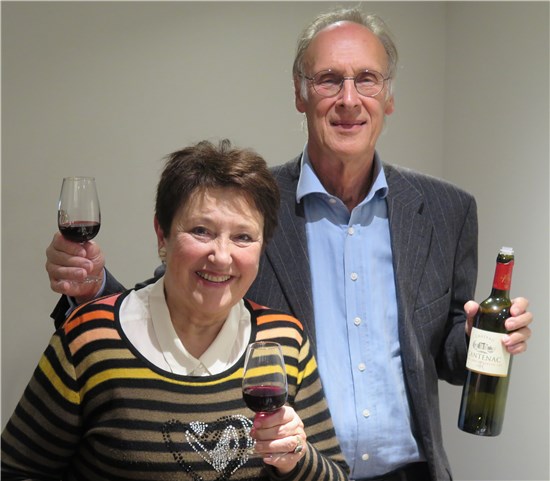 The November tasting provided welcome respite from the late Autumn weather with a classic St. Emilion vertical tasting! It was hosted by Dr. Gerald Sacks (an OWC member) and Madame Nicole Roskam-Brunot, of Chateau Cantenac – a Grand Cru St. Emilion property. Mme Roskam-Brunot is owner of the chateau and a member of the Jurade of St. Emilion (one of the first 5 women Jurats, as they are known [translation: judge]). The Jurade dates from 1199, having been incorporated by a charter from King John of England (which covered this part of France at that time), and granted the area a level of autonomy. King John’s likely rationale however, was to obtain a supply of good wine for his court! The Jurade originally governed the city, including civic, legal and administrative affairs (which included the quality of the wine!), even after the area became French sovereignty in the 15th century, until shortly after the French revolution. It was revived in 1948 by growers to raise the profile of wines of the area, and continues to play a ceremonial role in celebrating events in the wine calendar.
The November tasting provided welcome respite from the late Autumn weather with a classic St. Emilion vertical tasting! It was hosted by Dr. Gerald Sacks (an OWC member) and Madame Nicole Roskam-Brunot, of Chateau Cantenac – a Grand Cru St. Emilion property. Mme Roskam-Brunot is owner of the chateau and a member of the Jurade of St. Emilion (one of the first 5 women Jurats, as they are known [translation: judge]). The Jurade dates from 1199, having been incorporated by a charter from King John of England (which covered this part of France at that time), and granted the area a level of autonomy. King John’s likely rationale however, was to obtain a supply of good wine for his court! The Jurade originally governed the city, including civic, legal and administrative affairs (which included the quality of the wine!), even after the area became French sovereignty in the 15th century, until shortly after the French revolution. It was revived in 1948 by growers to raise the profile of wines of the area, and continues to play a ceremonial role in celebrating events in the wine calendar.
The evening started with an aperitif - always a good way to keep our palates entertained while we learn about the background to the tasting! While Gerald outlined the geography and history of St. Emilion and Nicole explained the chateau’s approach to wine, we sipped on a Vouvray Brut NV by Alain Robert. Not of course a Bordeaux wine (let alone St. Emilion), but the Loire classic was an excellent opener with a good, clear, fresh lemon zest nose and gentle mousse of bubbles. It had excellent balance, with restrained alcohol (12.5%) and a good body of fruit at its core - I had forgotten how nice Vouvray can be. During this, Gerald introduced the St. Emilion region by reminding us of the unusual latitude for growing cabernet sauvignon (45o north), which is the furthest north that the grapes will ripen. It is only due to the temperate climate in Bordeaux that it ripens at all – surrounded by the two great rivers of the Gironde and Garonne. He also reminded us of the complex geology of Bordeaux. On the left bank, there are deep gravel soils from its historical sea-bed origin, together with limestone and clay. At the end of the last ice age, the glacier that descended the river valley deposited rocks at the mouth of the Gironde, further enhancing the terroir for finely structured cabernet-based wine. In St. Emilion on the right bank of the Gironde, there is more clay marl – cooler and thus less advantageous for cabernet sauvignon, as a late-ripening grape. Merlot (60-70%) and cabernet franc (~30%) dominate here, as they are happier in the clay and cooler temperatures, flowering and ripening earlier (3-4th week of September) than the cabernet sauvignon, which ripens later (mid-October) and makes up only ~10% of the grapes on the right bank.
The commune of St. Emilion is relatively small, comprising around 5,000 hectares (~5% of the Bordeaux area). Chateau Cantenac has produced wine since 1870 and is 700m from Pomerol, with some illustrious neighbours – Cheval Blanc and Petrus. The soils are a mixture of sand (top), gravel (middle; retains heat) and clay (bottom), with more limestone and clay towards the top of the hill, where the cooler soils result in grapes picked around a week later than the rest of the property. The name comes from the Romanz word for enchanted place / piece of wood where vines grow. It is a family vineyard, in which Nicole works with two of her three sons, following an earlier career as a lawyer. In fact, all three of her daughters in law are oenologists so wine making is a serious family affair!
As a family business, Nicole described having to “make wines as a melody – sometimes as an opera, sometimes otherwise…!” The wine at Chateau Cantenac is generally 75% merlot, 25% cabernet and aged for 18 months (12-14 months in barrel), with a modest 40% new oak, avoiding the trend for more highly extracted wines with up to 200% new oak (two new oak barrels in sequence). The chateau tends to follow the old saying that “The oak has to follow, not to lead, the wine – like a woman’s perfume!” Two main cuvees of the grand vin are produced – a selection Madame with around 1 yr in barrel, designed as a more elegant version for European consumption, and the other with over a year in barrel, aimed at the overseas market. The grand vin is seductive and deep in colour, with aromas of ripe fruit, undergrowth and fine spices. The mouth is full, framed by noble and spicy notes, with a smooth, long finish.
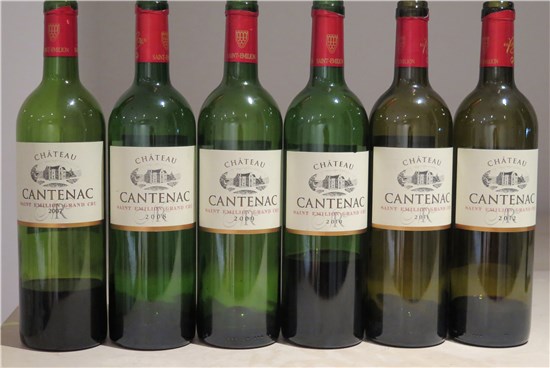 Nicole decided to deviate from the usual reverse date order of wines for the evening, to better illustrate different aspects of the wines, and we tasted the vintages in pairs. We started nonetheless with the youngest pair of the evening – the 2012 and 2011 vintages. The 2012 won a Gold Medal at the International Wine Contest in Lyon 2015 and was described by Guide Gilbert & Gaillard as “Dark in colour with violet hues. Racy nose with hints of red and black fruits. In the mouth very silky, elegant, fine tannins. A controlled power that showcases a mature and rather persistent fruit.” I tended to agree, and found the wine to have a generosity of fruit despite its young age, with good likely ageing potential. It had a dark ruby colour with purple rim, and a typical merlot-dominated nose and taste - fleshy and rounded, with good fruit – red berries and blackcurrant, with a lingering finish. A classically structured St. Emilion, with the best yet to come. The 2011 won a silver medal at the Decanter World Wine Awards 2014 and was described as "Rich toasty, roasted coffee scented nose with blackcurrant, cedar and herbs. Stylish and robust wine, super-charged almost, with lovely immediate impact and full, opulent, sweet fruit flavour. Long, with a reassuringly firm structure.” I agreed with the ‘firm structure’ description, and found it had a liquorice nose with grippy tannins and a ‘classic’ Bordeaux style (i.e. lean…) without the generosity of fruit of the 2012. Perhaps in time, it will blossom?
Nicole decided to deviate from the usual reverse date order of wines for the evening, to better illustrate different aspects of the wines, and we tasted the vintages in pairs. We started nonetheless with the youngest pair of the evening – the 2012 and 2011 vintages. The 2012 won a Gold Medal at the International Wine Contest in Lyon 2015 and was described by Guide Gilbert & Gaillard as “Dark in colour with violet hues. Racy nose with hints of red and black fruits. In the mouth very silky, elegant, fine tannins. A controlled power that showcases a mature and rather persistent fruit.” I tended to agree, and found the wine to have a generosity of fruit despite its young age, with good likely ageing potential. It had a dark ruby colour with purple rim, and a typical merlot-dominated nose and taste - fleshy and rounded, with good fruit – red berries and blackcurrant, with a lingering finish. A classically structured St. Emilion, with the best yet to come. The 2011 won a silver medal at the Decanter World Wine Awards 2014 and was described as "Rich toasty, roasted coffee scented nose with blackcurrant, cedar and herbs. Stylish and robust wine, super-charged almost, with lovely immediate impact and full, opulent, sweet fruit flavour. Long, with a reassuringly firm structure.” I agreed with the ‘firm structure’ description, and found it had a liquorice nose with grippy tannins and a ‘classic’ Bordeaux style (i.e. lean…) without the generosity of fruit of the 2012. Perhaps in time, it will blossom?
The 2008 and 2007 vintages followed – both more difficult years but with a little more maturity. The 2008 was described by the Dussert Gerber Guide 2014 as “Continues to evolve, all in colour and material, with persistent notes of cherry and smoky, with rich tannins, a beautiful dark ruby, ample wine and spicy in the mouth guard.” – it gained 16/20 from Jancis Robinson. For me, it had a more evolved nose with some vegetal notes, and a peppery classic palate of ripe cassis with a little tobacco. More interesting than the first pair, and generally good value in the shops. 2007 started with a cold, wet spring, but hard work in the vineyard resulted in a good wine. Also scoring 16/20 from Jancis, and described as “Neat and well balanced with real energy and completeness on the palate.” I agreed with Jancis (for what it’s worth!) – a well balanced wine, with a hint of tertiary aromas and some evolution on the rim. A little more toasty, with an earthy wood flavour.
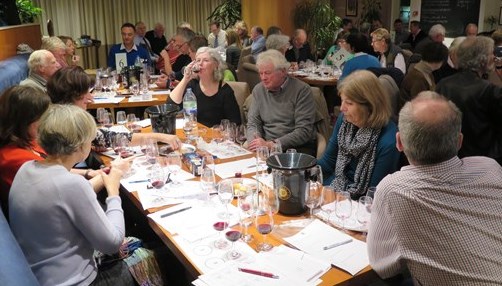 Next came the two great vintages from recent years – 2009 and 2010. 2009 was a warm year, with generous fruit and more exotic flavours generally across Bordeaux. Nicole felt it had a cherry flavour with hints of coconut, while James Suckling described it in the Wine Spectator as “Blueberry and mineral on the nose, with hints of fresh flowers. Full and layered, with superpolished tannins and long finish.” For me, it was the more enjoyable wine of the pair to drink now, with good fruit and some evolved, tertiary flavours. While still requiring time to reach its peak, it was the more feminine of the pair and the softer edges allowed for earlier drinking. 2010 was the second great year in a row in Bordeaux, despite much scepticism that it could be so! Nicole even told her children in 2009 that years like the one they had just had were a ‘once in a generation’ event! The taste impressed too, and James Suckling thought that “The purity of fruit in this young wine is impressive with red and purple blueberry aromas. Full body, with intense year centre palate of beautiful fruit. Long finish with hints of liquorice and berries”, while the Winespectator felt it was an “Extracted style, thickly layered with plum, blackberry preserves and pastis rating woven with ample ganache and melted liquorice, Followed by a long, thickly coated, tarry finish”. I found it had an abundance of good fruit, and although still purple on the rim, already had a cherry menthol nose (perhaps what others had described as liquorice?), and raspberry, blueberry and wood on the palate. A very long finish. Still in its youth however, and destined to be a really good wine - perhaps in time better than the 2009.
Next came the two great vintages from recent years – 2009 and 2010. 2009 was a warm year, with generous fruit and more exotic flavours generally across Bordeaux. Nicole felt it had a cherry flavour with hints of coconut, while James Suckling described it in the Wine Spectator as “Blueberry and mineral on the nose, with hints of fresh flowers. Full and layered, with superpolished tannins and long finish.” For me, it was the more enjoyable wine of the pair to drink now, with good fruit and some evolved, tertiary flavours. While still requiring time to reach its peak, it was the more feminine of the pair and the softer edges allowed for earlier drinking. 2010 was the second great year in a row in Bordeaux, despite much scepticism that it could be so! Nicole even told her children in 2009 that years like the one they had just had were a ‘once in a generation’ event! The taste impressed too, and James Suckling thought that “The purity of fruit in this young wine is impressive with red and purple blueberry aromas. Full body, with intense year centre palate of beautiful fruit. Long finish with hints of liquorice and berries”, while the Winespectator felt it was an “Extracted style, thickly layered with plum, blackberry preserves and pastis rating woven with ample ganache and melted liquorice, Followed by a long, thickly coated, tarry finish”. I found it had an abundance of good fruit, and although still purple on the rim, already had a cherry menthol nose (perhaps what others had described as liquorice?), and raspberry, blueberry and wood on the palate. A very long finish. Still in its youth however, and destined to be a really good wine - perhaps in time better than the 2009.
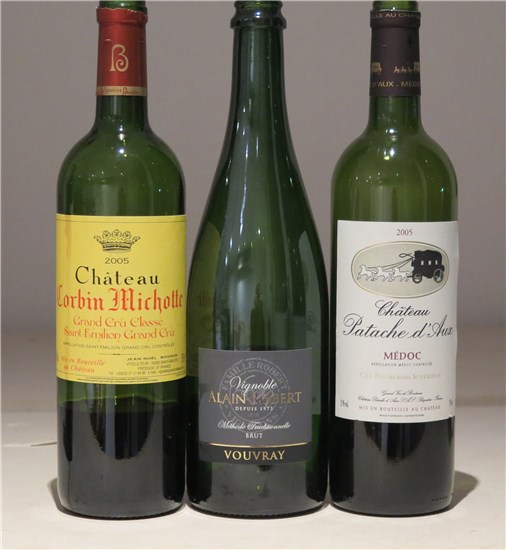 The final pair were tasted blind. Two mature Bordeaux wines which turned out to be from the same year, but very contrasting styles. Clearly from a good vintage, we guessed at 2005 or possibly 2000/2001, and it turned out to be 2005 for both. The first was a Chateau Corbin-Michotte (St. Emilion Grand Cru) – 65% merlot, 30% cabernet franc, 5% cabernet sauvignon. This was a beautifully nature Bordeaux, with an orangey-red rim, great fruit and beautiful balance, perfectly ready to drink now. Earthy sous-bois flavours mixing with red fruits and an evolved nose with jammy tertiary aromas. Delicious! The second was quite different – a Chateau Patache d’Aux (Medoc) – 60% cabernet sauvignon, 30% merlot, 7% cabernet franc, 3% petit verdot. This was more closed still, with little on the nose (slight blackcurrant aromas only) and reasonable fruit but little to excite. We wondered if our bottle was faulty, but it may simply be too immature still (in common with several 2005’s) – time may tell.
The final pair were tasted blind. Two mature Bordeaux wines which turned out to be from the same year, but very contrasting styles. Clearly from a good vintage, we guessed at 2005 or possibly 2000/2001, and it turned out to be 2005 for both. The first was a Chateau Corbin-Michotte (St. Emilion Grand Cru) – 65% merlot, 30% cabernet franc, 5% cabernet sauvignon. This was a beautifully nature Bordeaux, with an orangey-red rim, great fruit and beautiful balance, perfectly ready to drink now. Earthy sous-bois flavours mixing with red fruits and an evolved nose with jammy tertiary aromas. Delicious! The second was quite different – a Chateau Patache d’Aux (Medoc) – 60% cabernet sauvignon, 30% merlot, 7% cabernet franc, 3% petit verdot. This was more closed still, with little on the nose (slight blackcurrant aromas only) and reasonable fruit but little to excite. We wondered if our bottle was faulty, but it may simply be too immature still (in common with several 2005’s) – time may tell.
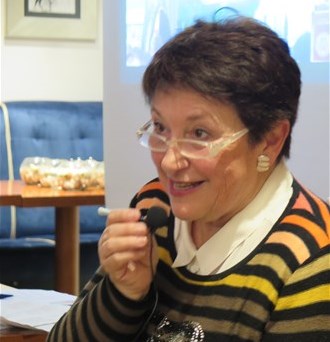 In general, many were agreed that this was an entertaining and enjoyable tasting. We took a vote in the room on the favourite Chateau Cantenac vintage of the evening, with 2010 winning most votes and 2009 almost as many. 2007 garnered a few supporters, but there were no votes for the other years. Peter Hendricks gave the vote of thanks to both Gerald Sacks and Madame Nicole Roskam-Brunot – a fine and enchanting double act he felt. Perhaps the last word should go to a sign in St. Emilion highlighted in the tasting: “N’ecoute pas ton medicin; fais comme lui – bois un bon vin” (translation: “Don’t listen to your doctor, do as he does and drink a good wine”!).
In general, many were agreed that this was an entertaining and enjoyable tasting. We took a vote in the room on the favourite Chateau Cantenac vintage of the evening, with 2010 winning most votes and 2009 almost as many. 2007 garnered a few supporters, but there were no votes for the other years. Peter Hendricks gave the vote of thanks to both Gerald Sacks and Madame Nicole Roskam-Brunot – a fine and enchanting double act he felt. Perhaps the last word should go to a sign in St. Emilion highlighted in the tasting: “N’ecoute pas ton medicin; fais comme lui – bois un bon vin” (translation: “Don’t listen to your doctor, do as he does and drink a good wine”!).
by Saul Myerson